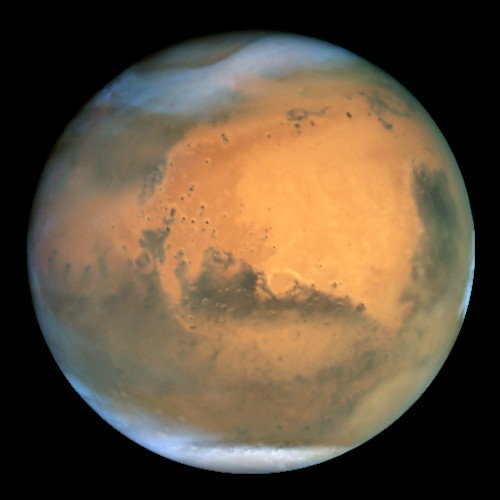Mysterious Haze on Mars Leaves Scientists Baffled
| Ana Verayo | | Feb 17, 2015 04:57 AM EST |
(Photo : NASA and The Hubble Heritage Team (STScI/AURA)) An image captured by the Hubble space telescope and the mystery clouds over Mars.
A mysterious haze that enveloped the atmosphere of Mars apparently violated known physical laws that say it shouldn't exist at all. It baffled astronomers trying to determine the cause and the composition of the formation.
Astronomers first observed the haze in March and April 2012. The haze apparently appeared twice in the same region and was first seen by amateur astronomers.
Like Us on Facebook
This dark haze reached as high as 150 miles (250 km), well up into the Martian atmospherea and almost at the edge of space. This extreme altitude is the most puzzling aspect of this feature to scientists since the Martian atmosphere is so thin and fragile it can't support the formation of an object extending that high into the atmosphere.
Some features similar to this haze were also observed in the atmosphere, but only some 60 miles above the surface.
The haze covered a massive area of 625 miles by 300 miles. It transformed and evolved over a span of 10 days before it finally disappeared.
There are many images from the Hubble Space Telescope and other photos from observatories and amateur astronomers that witnessed several clouds rising to heights of 60 miles or more.
According to Agustin Sanchez-Lavega of the Universidad del País Vasco, Spain, these features can be caused by a reflective cloud made from water, carbon dioxide ice and dust particles. The haze was unique since it deviated from standard atmospheric circulation models and formed at unusually high altitudes.
Aurora borealis lights might also have caused the haze on Mars since these were observed in the same regions as the haze. Unusual magnetic activity apparently prevails over certain areas of the Red Planet.
Scientists believe that if these auroras are causing storms, these are estimated to be 1,000 times more powerful than those seen here on Earth. It's also not possible that dust from the surface picked up by powerful winds is the cause of this dark haze since the dust rose some 37 miles into the atmosphere.
In 2016, the European Space Agency's ExoMars Trace Gas Orbiter will be launched to observe and study this phenomenon along with a joint mission of Roscosmos, also in 2016.
TagsMysterious Haze on Mars Leaves Scientists Baffled, ESA, NASA, haze on mars, Mars, mars exploration, mysterious haze scientists baffled puzzled plumes clouds, mysterious haze mars scientists plume clouds
©2015 Chinatopix All rights reserved. Do not reproduce without permission
EDITOR'S PICKS
-

Did the Trump administration just announce plans for a trade war with ‘hostile’ China and Russia?
-

US Senate passes Taiwan travel bill slammed by China
-

As Yan Sihong’s family grieves, here are other Chinese students who went missing abroad. Some have never been found
-

Beijing blasts Western critics who ‘smear China’ with the term sharp power
-

China Envoy Seeks to Defuse Tensions With U.S. as a Trade War Brews
-

Singapore's Deputy PM Provides Bitcoin Vote of Confidence Amid China's Blanket Bans
-

China warns investors over risks in overseas virtual currency trading
-

Chinese government most trustworthy: survey
-

Kashima Antlers On Course For Back-To-Back Titles
MOST POPULAR
LATEST NEWS
Zhou Yongkang: China's Former Security Chief Sentenced to Life in Prison

China's former Chief of the Ministry of Public Security, Zhou Yongkang, has been given a life sentence after he was found guilty of abusing his office, bribery and deliberately ... Full Article
TRENDING STORY

China Pork Prices Expected to Stabilize As The Supplies Recover

Elephone P9000 Smartphone is now on Sale on Amazon India

There's a Big Chance Cliffhangers Won't Still Be Resolved When Grey's Anatomy Season 13 Returns

Supreme Court Ruled on Samsung vs Apple Dispute for Patent Infringement

Microsoft Surface Pro 5 Rumors and Release Date: What is the Latest?










